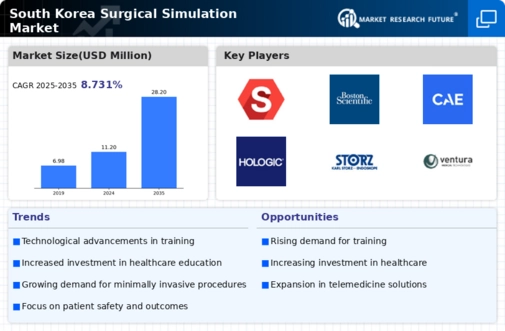The South Korea Surgical Simulation Market has been gaining significant traction due to the increasing emphasis on improving surgical skills and enhancing patient safety. Factors such as technological advancements, a growing demand for minimally invasive surgical procedures, and the ongoing shift towards patient-centric approaches in healthcare are driving the market's evolution. The competitive landscape is characterized by a mix of established players and innovative newcomers who are leveraging cutting-edge technologies, such as virtual reality and artificial intelligence, to provide enhanced simulation training for surgical professionals.
The collaboration between academic institutions and healthcare providers is also fostering the development of realistic surgical training environments. As the market expands, key players are focusing on expanding their product offerings and exploring potential partnerships to capitalize on growth opportunities.
Stryker Corporation has established a solid presence in the South Korea Surgical Simulation Market, benefiting from its reputation for quality and reliability in surgical equipment and training solutions. The company's strengths lie in its extensive range of simulation products designed for various surgical disciplines, which allows it to cater to a diverse customer base, including hospitals and medical schools. Stryker's commitment to innovation positions it favorably within the market, as it continually invests in research and development to enhance its training tools and technologies.
The corporation's robust distribution network and strategic collaborations with local healthcare providers further enhance its market penetration, enabling it to respond effectively to the evolving needs of the healthcare sector in South Korea.
LAP Medical is another key player in the South Korea Surgical Simulation Market, known for its innovative approaches to surgical training and education. The company offers a range of products and services focused on high-fidelity surgical simulation, which includes advanced training mannequins and simulation systems that allow practitioners to refine their skills in a controlled environment. LAP Medical's strengths lie not only in its product offerings but also in its commitment to customer engagement and support, ensuring that healthcare professionals receive comprehensive training resources.
Additionally, LAP Medical has pursued strategic mergers and acquisitions to bolster its market presence, further expanding its capabilities and product portfolio tailored to the specific needs of the South Korean healthcare industry. Through these initiatives, LAP Medical demonstrates its dedication to enhancing surgical education and training in South Korea, solidifying its position as a trusted provider in this competitive landscape.








